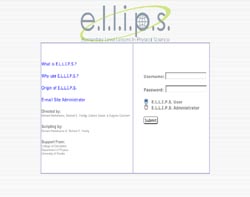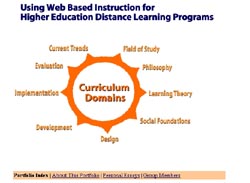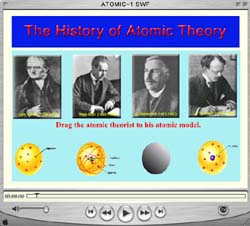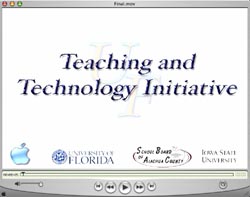Multimedia & Hypermedia
(Flash, Director, Web-Based, & Database) |

Elementary Level Lessons in Physical Science
http://ferdig.coe.ufl.edu/pt3physics/
http://ferdig.coe.ufl.edu/pt3physics/
E.L.L.I.P.S. is a hypermedia environment consisting of an accumulation of numerous primary level Physical Science activities, a teacher discussion board, review mechanisms, and user organizational functions. |

|
Who Wants To Be An Edugator?
http://www.coe.ufl.edu/webtech/Edugator/Edugator.htm
This project was a class collaboration that incorporated research compiled on many individuals that have contributed to fields such as Education, Educational Psychology, Educational Technology, and Technology. The game is modeled after the popular "Who Wants To Be a Millionaire?" game. In this game, however, players climb Century Tower, located at the University of Florida until they miss a question. |

|
Great Ideas in Education
http://www.coe.ufl.edu/webtech/GreatIdeas/index.htm
Associated with the game "Who Wants To Be An Edugator?" is this website containing biographies and various information on the individuals included in the game. This site is attached to the "Edugator Game" so that people can learn more about these educators. |

|
Distance Learning Portfolio Project
::[not linked here]
This project was a group collaboration on Distance Learning as it relates to the entire field of curriculum. Areas of focus were Development, Design, Implementation, Evaluation, Current Trends, and others, as they relate to Distance Learning. |
|
Energy Transfer Multiple Perspectives Project
::[not linked here]
This project was an exploration into Multiple Perspectives. The project consists of a single topic being investigated from various contexts. Within each context, there are various instructional resources that could be integrated into classroom lesson plans or used by students in researching various aspects of a single topic. |

|
Time Machine Webquest
http://www.coe.ufl.edu/webtech/Timemachine/tmstudentteacher.htm
This project was a course collaboration that integrated many areas of curriculum. Individuals in the course created webquests that focused on a particular content area (science, math, etc.) These individual webquests were then grouped by subject area and integrated into a single website. |

|
History of Atomic Theory Game::[Flash player version]
This was the final project in the animation course. It involved the creation of an educational tool using Flash 5. It was completed after becoming familiar with the Flash environment. In this game, the user must match a particular scientist to his atomic model. If correct, the user continues. If the user responds incorrectly, he/she is taken to a "hint" page, specific to each scientist. Each "hint" page includes a hyperlink, in which the student can discover more information about a particular scientists model. After the game is complete, the user is given the option of visiting a number of resources that discuss the history of atomic theory. |

|
PowerHouse Project::[This file is too big for the web version of the portfolio--refer to DVD version]
This project was a cross-class collaboration that incorporated skills from the students of two courses. Students in a design oriented class created rooms for a house, and students of Human-Computer Interactivity and the Learner wrote the scripting and created the interface. The design was done using Adobe PhotoShop, and the scripting was done using Director 8. The project may eventually be put on the Internet as free software for educators. |

|
Flash Plane Game::[Plane Game vs. MiGs: Flash Player]
This project was the second in an Animation course. This involved the use of Flash and PhotoShop. Unlike the first project, the Plane Game involved extensive programming in the Flash realm. In the game, players shoot down airplanes of varying size as they cross the screen. After they run out of ammunition, the game is over, and the player is assigned a rank--depending upon their score. |

Nutrition Video::[This file is too big for the web version of the portfolio--refer to DVD version]
This movie was created using a variety of video capturing and editing software, as well as image editing software. The idea was to present an interesting, informative, and visually appealing video about "nutrition". This video was designed to be used as an additional resource when teaching about nutrition. The goal of this project was to be able to manipulate various video and image editing software to create an educational tool. |

|
Ohm's Law Video::[This file is too big for the web version of the portfolio--refer to DVD version]
This project was an exploration of Apple's iMovie software. The idea was to videotape a Physics laboratory experiment and edit it with iMovie. This tool could then be used as an introduction to the experiment, or an addendum to the experiment in the case of absenteeism or some other occurrence. The goal of this project was to be able to manipulate iMovie and create educational tools with its use. |

|
PT3 Grant Video::[This file is too big for the web version of the portfolio--refer to DVD version]
This project was completed in the course Designing Integrated Environments. First, it was an exercise in the process of shooting, logging, and capturing video. There was a focus on various techniques in shooting video. Secondly, it was an exercise in editing video. Finally, it was an exercise in learning video editing software--in this case, Final Cut Pro. The video outlined the goals and accomplishments of the PT3 grant at the University of Florida, and was shown at the 2002 SITE Conference in Nashville, TN, at the University of Florida Poster Session. |
|





